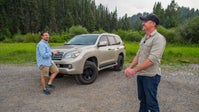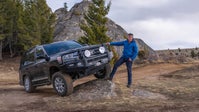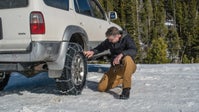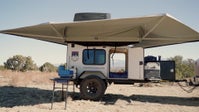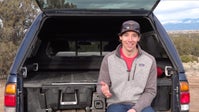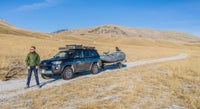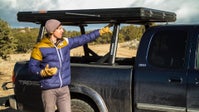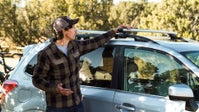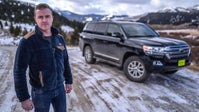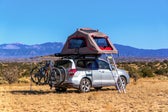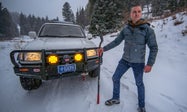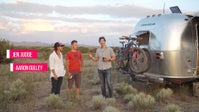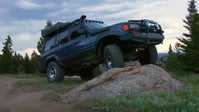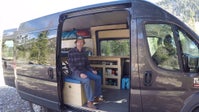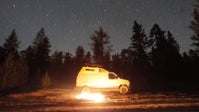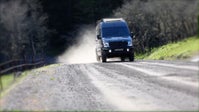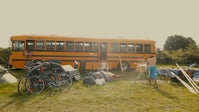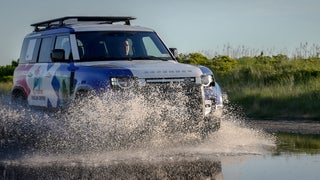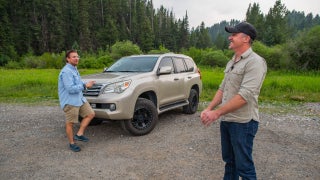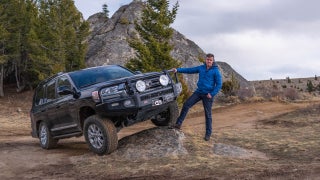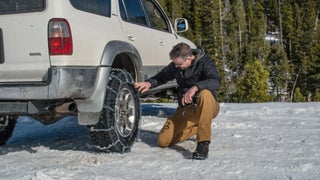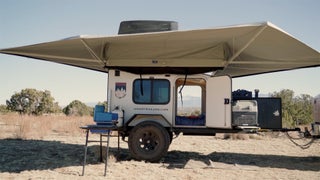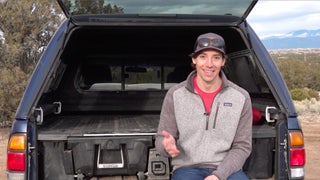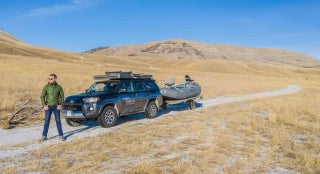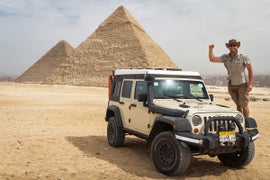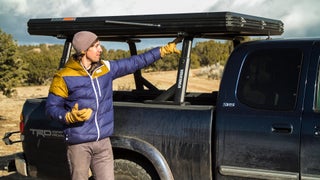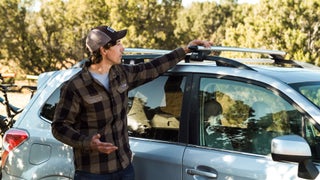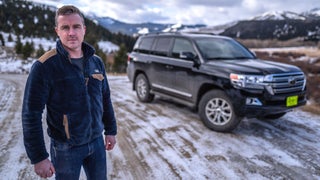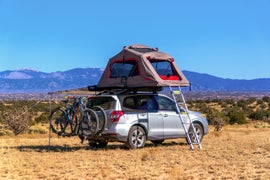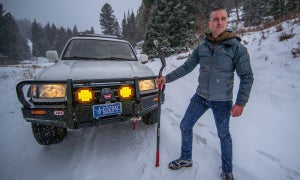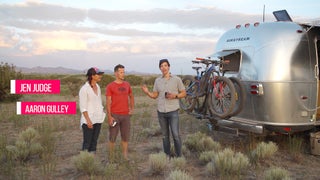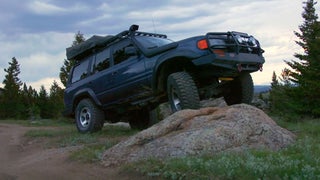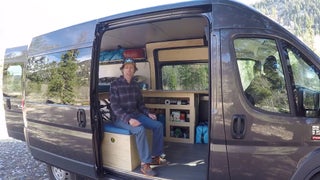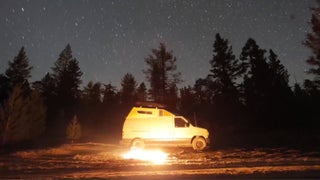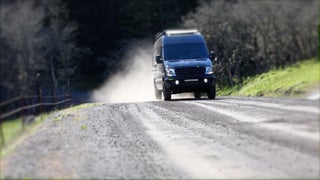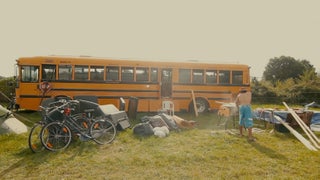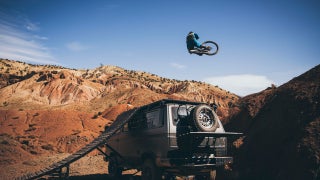[ROCK MUSIC] WES SILER: On today's episode, we're going to show you how to tow a trailer. And you may be asking yourself, why is trailer-towing an outdoor skill? And the reason is that it facilitates adventure. Towing a trailer allows you to bring sports equipment along, like this raft, or jet skis, or snowmobiles, or just take a bunch of stuff on a big camping trip.
And it allows you to do that really cheaply and really easily because you can use your existing car. No matter what you have, it can tow. Even a Toyota Prius can tow 1,600 pounds. That's more than a pickup truck can carry in its bed.
So this is really a cheap, easy way to do more outdoors. And we're going to show you how.
[THEME MUSIC]
So the neat thing about a trailer is that allows you to carry so much more stuff in weight than you could ever carry in any other way. That's because that weight's on its own set of axles, with only a little portion of it on your actual vehicle. So you can carry giant things like this raft, or heavy things like a moving trailer, or sports equipment like jet skis or snowmobiles that you're just never going to get in the back of a truck, never going to get on your roof. Trailers really open up a lot of neat capabilities.
Have you ever seen those YouTube videos where the trailer just, like, sways out of control and eventually just, like, drags the car that's towing it off the road? That's because they're carrying the weight wrong.
And the most important safety tip while towing a trailer is that you need to get 60% of the total weight of your load in front of the trailer's axles. So at least 60% up here, and you won't be the next viral YouTube video of a car crash.
The big downside of towing a trailer is that it's really going to affect your fuel economy. In a smaller passenger vehicle that doesn't have to carry a lot of weight normally, you're going to see your range fall by half with a trailer on the back.
And as a result, it's probably smart to go ahead until you get a handle on what your new range is to just carry a jerry-can, carry some extra fuel. And that way, you're not going to run out in the middle of nowhere.
How do you get a trailer? Rent one. That way, the storage, the maintenance, and the purchase price is somebody else's problem. You can rent a utility trailer from U-Haul starting at $12 a day with no mileage fees. Or if you want to come on an adventure here in Montana and do the stuff you see us doing, you can rent everything you see here from our friends at Hatch ║┌┴¤│ď╣¤═°s in Bozeman.
How do you connect the trailer to your car? First thing you need is a hitch. U-Haul will sell you one of these for 150 bucks, installed. The best place to get one, you get a 2-inch receiver. Then you need a ball and a socket that match. And you just put them one on the other. There you go.
Put that lever down to lock it on. Safety pin. What these chains do is give you a backup. In case the trailer becomes detached, these will stop it from flying down the road and killing somebody. Trailer wiring, turns signals, brake lights, fun stuff like that.
And this is really simple. Anybody can do it. Get a buddy, and check your trailer lights every time. Turn signals.
MAN: Yep.
WES SILER: Tail lights.
MAN: Yep.
WES SILER: Brake lights.
MAN: On.
WES SILER: Awesome. Good to go.
Once you're in the car, go ahead and take the time to readjust your wing mirrors. You want to be able to see the trailer wheels in them just a little bit, while still being able to see traffic behind you. And that way, when you pull into a gas station or take a tight corner, you can keep an eye on your trainer wheels to make sure you don't run over anything.
So actually driving with a trailer attached-- you know what I'm going to tell you, drive slowly. But you need to consider some things when you're slowing down.
Brake a little earlier than you might otherwise. Brake a little sooner. Leave a little more distance, and that way, you don't have to break as hard. And if you're coming down a long mountain hill, go ahead and take manual control of your gears, and use those to control your speed, rather than just your brakes. That'll stop your brakes from overheating with all that extra weight behind you.
So when you're taking turns-- and I mean, like, 90-degree street turns-- you want to run those a little wider with trailers in the back, just to avoid any binding between the trailer and the car.
How heavy a trailer can your car tow? It's in your owner's manual. Look for your max trailer tow rating, and do not exceed it. That's extremely important for safety.
I moved us here last summer from Los Angeles. And I did the entire trip twice. And I never reversed once. You don't have to reverse. I'm going to show you how. It is never that much fun.
The general tip here is that put your hands on the bottom of the steering wheel. And if you want the trailer to go right, move your right hand up. If you want the trailer to go left, move your left hand up. It is difficult to explain. It's difficult to comprehend when somebody's explaining. It feels a little more intuitive when you're in the vehicle, but not really.
It just-- this is what it is. Just go slow. If you do find yourself in a bind, just pull out straight and give it a try again. But yeah, go slow.
All right, let's give this a try. We want the trailer to go right. So yeah, yeah, it's turning. It's turning all right. Yeah, we're going to go slower on this one. Oop, we are a little too tight there, so we're just going to pull up here, straighten things out a little bit. And again, take your time. Get this right. You are-- oh, no, too much. Yeah, this is one of those practice-makes-perfect things.
Again, I'm using my wing mirrors. Straighten out. A little more turn. A little less turn. Oh, my god. There we go. [INAUDIBLE] turn though.
So that's towing a trailer. It's going to save you some money. It's going to allow you to do some more exciting activities outdoors without the help of other people. And it really doesn't have to be that intimidating or challenging, as long as you drive a little slower, spend a little more effort on planning ahead, and not reversing whenever possible, but when you do have to reverse, just taking it easy, being prepared to admit you made a mistake, and straighten out, and just allowing the time to get it right. That's it.

